
Concept explainers
(a)
Interpretation:
The product on reaction of
Concept introduction:
The replacement or substitution of one
Answer to Problem 18.46AP
No product is formed on reaction of
Explanation of Solution
The reaction of
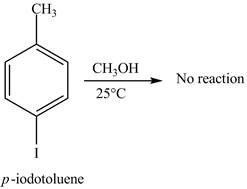
Figure 1
Aryl iodides cannot undergo nucleophilic substitution reaction. Aryl iodides neither undergo
There is no product formed on reaction of
(b)
Interpretation:
The product on reaction of
Concept introduction:
The replacement or substitution of one functional group with another different functional group in any chemical reaction is termed as substitution reaction. The electron rich chemical species that contains negative charge or lone pair of electrons are known as nucleophile. In nucleophilc acyl substitution reaction, nucleophile takes the position of leaving group.
Answer to Problem 18.46AP
No product is formed on reaction of
Explanation of Solution
The reaction of
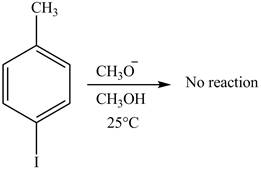
Figure 2
Aryl iodides cannot undergo nucleophilic substitution reaction. Aryl iodides neither undergo
There is no product formed on reaction of
(c)
Interpretation:
The product on reaction of
Concept introduction:
The replacement or substitution of one functional group with another different functional group in any chemical reaction is termed as substitution reaction. The electron rich chemical species that contains negative charge or lone pair of electrons are known as nucleophile. In nucleophilc acyl substitution reaction, nucleophile takes the position of leaving group.
Answer to Problem 18.46AP
No product is formed on reaction of
Explanation of Solution
The product on reaction of
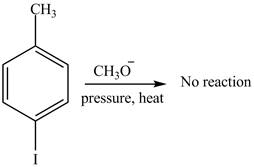
Figure 3
Aryl iodides cannot undergo nucleophilic substitution reaction. Aryl iodides neither undergo
There is no product formed on reaction of
(d)
Interpretation:
The product on reaction of
Concept introduction:
Grignard reagents are
Answer to Problem 18.46AP
The product on reaction of
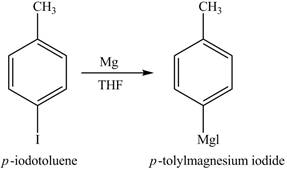
Explanation of Solution
The reaction of
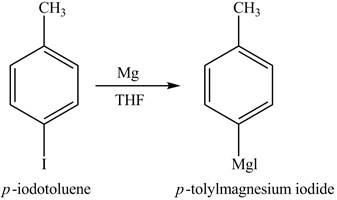
Figure 4
In the above reaction, magnesium gets inserted in the carbon-halogen bond to form a Grignard reagent. THF is used as the reaction should be done in anhydrous and inert condition. Therefore, the product formed on reaction of
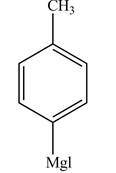
Figure 5
The reaction of
(e)
Interpretation:
The product on reaction of the product formed in part (d) with
Concept introduction:
Stille reaction is an example of coupling reaction. In Stille reaction, the triflate reacts with trimethylstannane in presence of
Answer to Problem 18.46AP
The product on reaction of the product formed in part (d) with
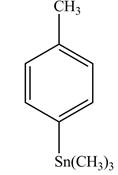
Explanation of Solution
The product formed in part (d) is shown below.
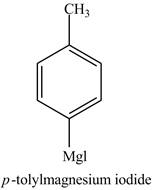
Figure 5
The reaction of the product formed in part (d) with
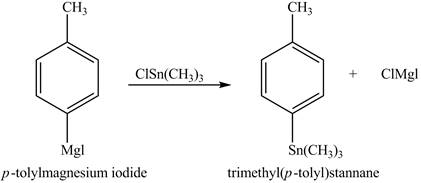
Figure 6
In the above reaction, a stannane compound is formed on reaction of a Grignard reagent with
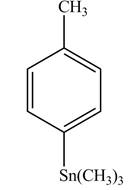
Figure 7
The product on reaction of the product formed in part (d) with
(f)
Interpretation:
The product on reaction of
Concept introduction:
Alkyl lithium is an organolithium reagent. It contains carbon-lithium bond. It is used in
Answer to Problem 18.46AP
The product on reaction of
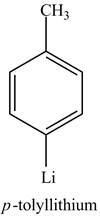
Explanation of Solution
The reaction of
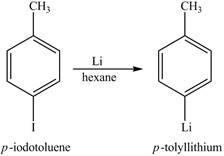
Figure 8
The above reaction is known as lithium-halogen exchange reaction. The reaction occurs under inert conditions. In this reaction, two moles of lithium react with

Figure 9
The product on reaction of
(g)
Interpretation:
The product on reaction of
Concept introduction:
The treatment of an organic halide with an
Answer to Problem 18.46AP
The product on reaction of
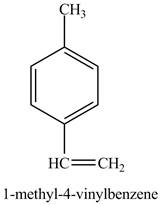
Explanation of Solution
The reaction of
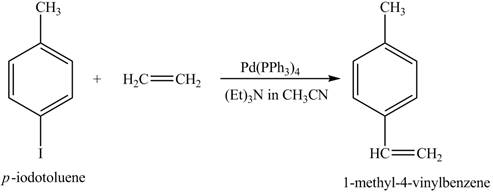
Figure 10
In the above reaction a coupled product is formed. The coupling takes place between ethene and
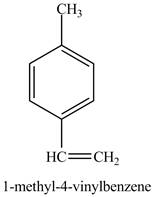
Figure 11
The product on reaction of
(h)
Interpretation:
The product on reaction of product of part (e) with phenyl triflate, excess
Concept introduction:
Stille reaction is an example of coupling reaction. In Stille reaction, the triflate reacts with trimethylstannane in presence of
Answer to Problem 18.46AP
The product on reaction of product of part (e) with phenyl triflate, excess
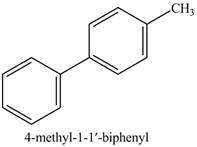
Explanation of Solution
The product formed in part (e) is shown below.
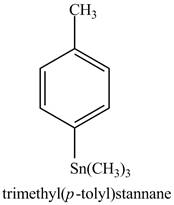
Figure 7
The reaction of above compound with phenyl triflate, excess
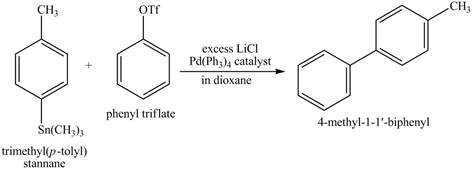
Figure 12
The above reaction is an example of Stille coupling reaction. In this reaction a triflate reacts with stannane compound in presence of
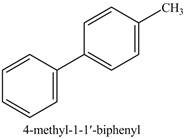
Figure 13
The product on reaction of product of part (e) with phenyl triflate, excess
(i)
Interpretation:
The product on reaction of
Concept introduction:
The Suzuki coupling reaction is a reaction in which an aryl or vinylic boronic acid is coupled to an aryl or vinylic iodide or bromide. It is a
Answer to Problem 18.46AP
The product on reaction of
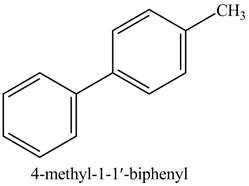
Explanation of Solution
The reaction of
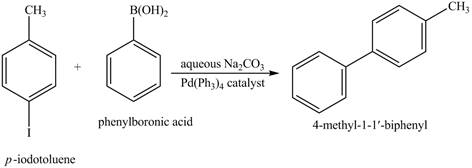
Figure 14
In the above reaction,
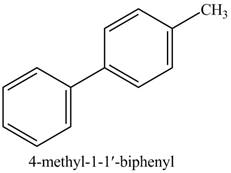
Figure 15
The product on reaction of
(j)
Interpretation:
The product on reaction of product of part (d) with
Concept introduction:
The Suzuki coupling reaction in which an aryl or vinylic boronic acid is coupled to an aryl or vinylic iodide or bromide. It is a
Answer to Problem 18.46AP
The product of part (d) with
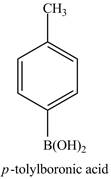
Explanation of Solution
The product of part (d) is shown below.
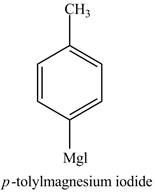
Figure 5
The reaction of product of part (d) with
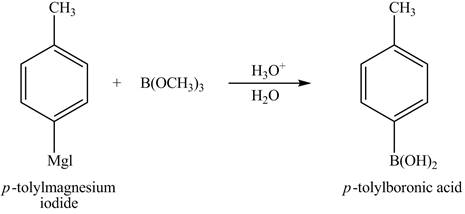
Figure 16
In the above reaction,
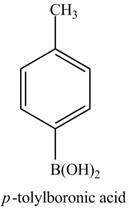
Figure 17
The product of part (d) with
(k)
Interpretation:
The product on reaction of product of part (j) with
Concept introduction:
The Suzuki coupling reaction in which an aryl or vinylic boronic acid is coupled to an aryl or vinylic iodide or bromide. It is a
Answer to Problem 18.46AP
The product on reaction of product of part (j) with
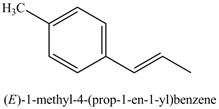
Explanation of Solution
The product of part (j) is shown below.
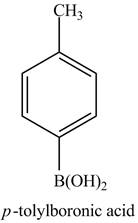
Figure 17
The reaction of product of part (j) with

Figure 18
The above reaction is Suzuki coupling reaction. In this reaction,
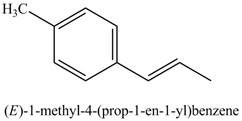
Figure 19
The product on reaction of product of part (j) with
Want to see more full solutions like this?
Chapter 18 Solutions
Organic Chemistry Study Guide and Solutions
- Answe Answer A and B pleasearrow_forward3. Refer to the data below to answer the following questions: Isoelectric point Amino Acid Arginine 10.76 Glutamic Acid 3.22 Tryptophan 5.89 A. Define isoelectric point. B. The most basic amino acid is C. The most acidic amino acid is sidizo zoarrow_forward3. A gas mixture contains 50 mol% H2 and 50 mol% He. 1.00-L samples of this gas mixture are mixed with variable volumes of O2 (at 0 °C and 1 atm). A spark is introduced to allow the mixture to undergo complete combustion. The final volume is measured at 0 °C and 1 atm. Which graph best depicts the final volume as a function of the volume of added O2? (A) 2.00 1.75 Final Volume, L 1.50 1.25 1.00 0.75 0.50 0.25 0.00 0.00 0.25 0.50 2.00 (B) 1.75 1.50 Final Volume, L 1.25 1.00 0.75 0.50- 0.25 0.00 0.75 1.00 0.00 0.25 Volume O₂ added, L 2 0.50 0.75 1.00 Volume O₂ added, L 2 2.00 2.00 (C) (D) 1.75 1.75 1.50 1.50 Final Volume, L 1.25 1.00 0.75 0.50 Final Volume, L 1.25 1.00 0.75 0.50 0.25 0.25 0.00 0.00 0.00 0.25 0.50 0.75 1.00 0.00 0.25 Volume O₂ added, L 0.50 0.75 1.00 Volume O₂ added, L 2arrow_forward
- Leucine is an essential amino acid with the systematic name 2-amino-3-methylpentanoic acid. It has pai 2.36 and pKa2 = 9.60. H2N-C(R)H-COOH and R is -CH2-CH(CH3)2 A. Draw the condensed structure for leucine, and label all chirality centers with an asterisk. B. How many possible stereoisomers of leucine are there? C. Draw a Fischer projection of L-leucine and label the chirality center(s) as R or S. D. What is the p/ of leucine? E. Draw the structure of the predominant form of leucine at 10.00. F. Draw the structure of the predominant form of leucine at pH = 1.50. G. Leucine is described as an essential amino acid. What does this mean? H. Show the alkyl halide you would use to prepare leucine by the amidomalonate method. =arrow_forwarda) Write out 6 completely different reactions of acetophenone (reagent, product). b) Write out 3 preparations of 1-methylcyclohexanol, using a different starting material for each one. You may use preps where you just change the functional group, and/or preps where you construct the carbon chain. c) Write out 3 preparations of 2-ethoxybenzoic acid, a different starting material for each one. You may use preps where you just change the functional group, and/or preps where you construct the carbon chain.arrow_forward12. CH3 OH OH H&C CH3 H₂C N OH H₂C CH3 H&C CH3 H₂C' CH3 H.C CH3OH H.C CH2CH3OH CH3CEN Which one of these 17 compounds is represented by this IR and this 'H NMR spectrum? IR Spectrum 3000 4000 3000 NMR Spectrum 2000 £500 RAVENUMBER 2000 1500 9 8 6 5 10 HP-00-290 ppm m 1000 500 1000 4 °arrow_forward
- Draw the structure of (E,6R) 6-methoxy-4-hepten-2-one. Give the IUPAC name of this compound, including stereochemistry. Draw the most stable chair conformation of (cis) 1,3-isobutylcyclohexane. H HC=CCH₂ CH2CH3 EN(CH3)2 -CN(CH3)2arrow_forward10. Write out the mechanism (intermediate/transition state) for this reaction; indicate stereochemistry in product. H3C CH₂OH CH3 SN1 Harrow_forwardWrite "most" under the member of each trio which is most stable. Write "least under the member of each trio which is least stable. b) Draw a Fischer projection of a pair of enantiomers with three chiral carbons. Which of these two would you expect to be more soluble in water? Why? 1-butanol 1-heptanol Which of these two would you expect to have the higher boiling point? Why? hexyl methyl ether 1-heptanolarrow_forward
- Write "most" under the most acidic compound. Write "least" under the least acidic compound. OH NO₂ OCH3 Br 9. Compound X, C50H84F2, reacts with excess H2/Pd to give a C50H88F2 compound. How many rings are in X? How many double bonds are in X? Show your work.arrow_forward4. State whether these two are: a) the same molecule b) c) d) different compounds that are not isomers constitutional isomers diastereomers e) enantiomers CH3 CH₁₂ H OH HO H H OH HO H CH, CH₂ 5. a) How many stereocenters does this compound have? b) How many stereoisomers are possible for this compound? CH₂ OH CHCHarrow_forwardCalculating the pH at equivalence of a titration A chemist titrates 210.0 mL of a 0.1003 M hydrobromic acid (HBr) solution with 0.7550M KOH solution at 25 °C. Calculate the pH at equivalence. Round your answer to 2 decimal places. Note for advanced students: you may assume the total volume of the solution equals the initial volume plus the volume of KOH solution added. pH = ] ☑ o0o 18 Ararrow_forward
 Chemistry: Principles and ReactionsChemistryISBN:9781305079373Author:William L. Masterton, Cecile N. HurleyPublisher:Cengage Learning
Chemistry: Principles and ReactionsChemistryISBN:9781305079373Author:William L. Masterton, Cecile N. HurleyPublisher:Cengage Learning
